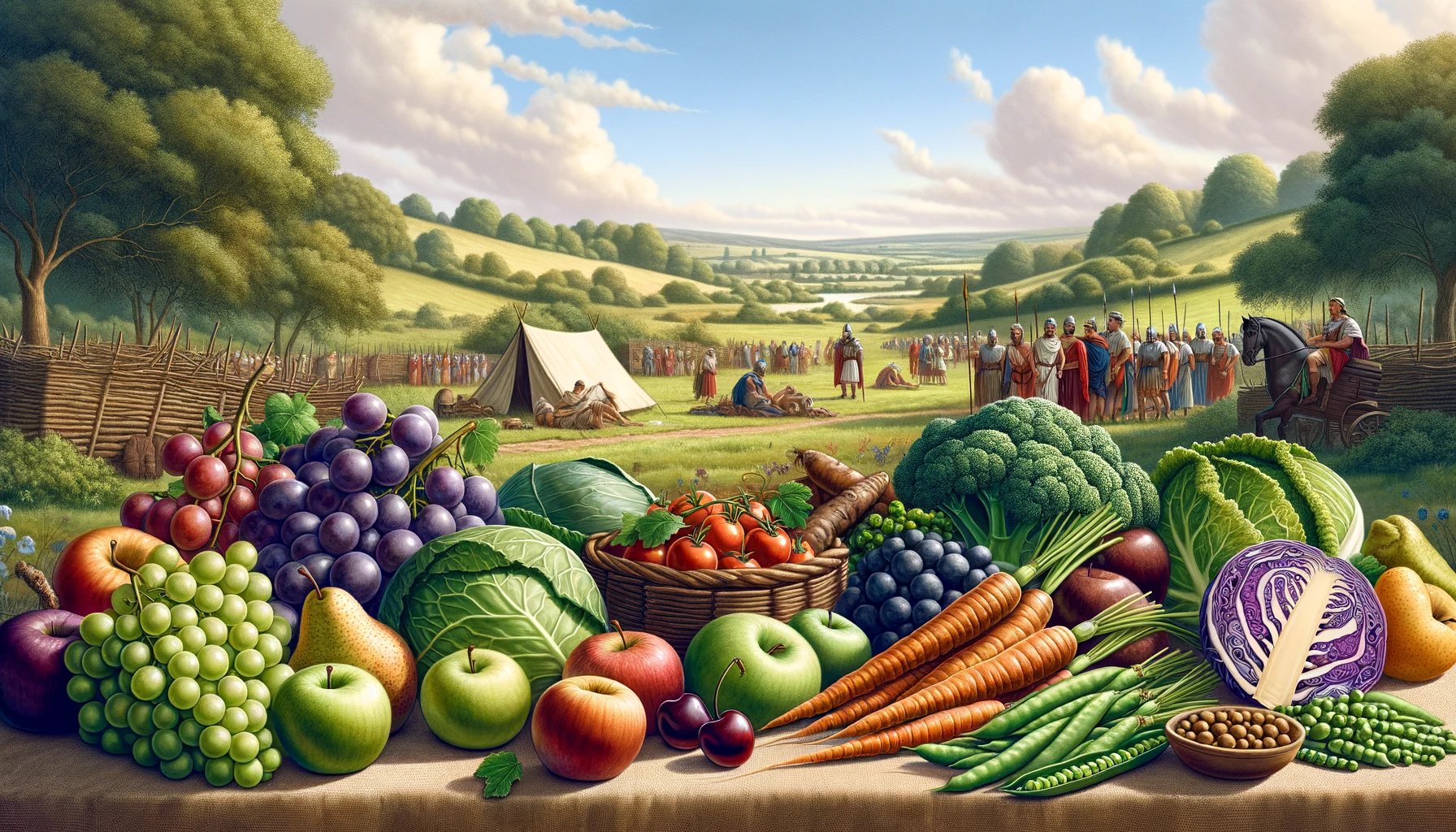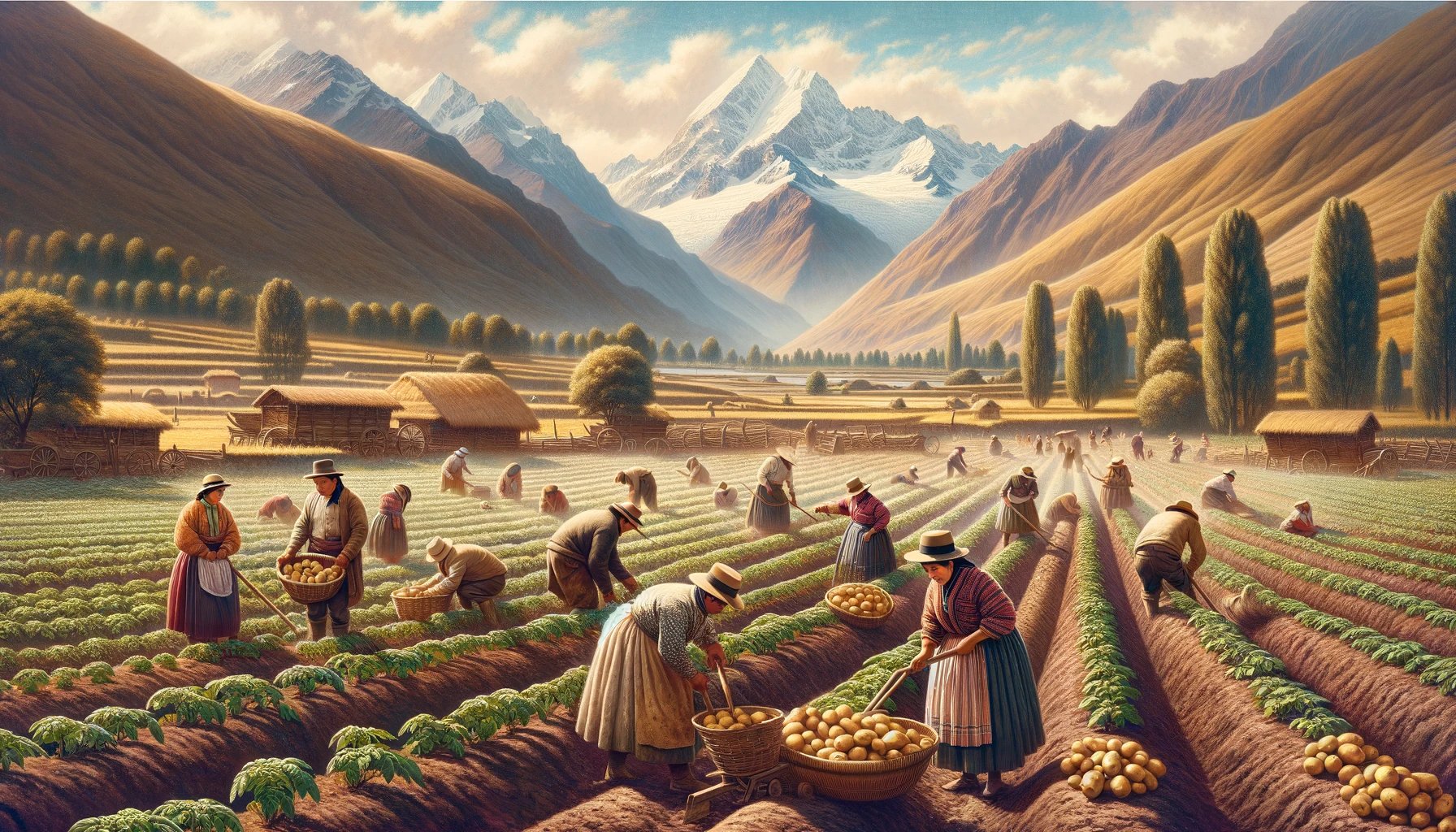What Have the Romans Ever Done for Us?
Apologies for quoting a Monty Python film in the title of this post, sorry not sorry and for those who have no idea where this reference came from, watch The Life of Brian, who says we are serious lot at new Foundation Farms!
Anyway…. what’s the point of this?
Throughout the history of the UK the movement of people has significantly influenced what we eat, how we eat, what grows and what we cultivate. In this article we will have a brief look at the timeline of invasion and what this means for indigenous foods as well as making the argument that as people travel and move they can create greater biological complexity than is native.
Colonisation brings everything humans bring, to put it very simply, a mixed bag of pros and cons but for the purpose of this article let’s consider the pros and specifically those relating to food and diversity.
The term ‘indigenous’ means simply of a place but when we attempt to ask the question what or who is indigenous to the UK things get complicated. The concept of indigenous people is more commonly associated with countries that have experienced colonisation or significant displacement of their native populations by external forces. While the UK has a rich history of various peoples and cultures, it may not fit the traditional definition of indigenous peoples in the same way that some other regions do but the term has meaning but the meaning is perhaps broader.
The UK's population includes a mix of different ethnic groups, including the Celts, Anglo-Saxons, Norse, Normans, and more recently, immigrants from various parts of the world. Some people may identify as indigenous to specific regions within the UK, such as the Welsh, Scottish, or Cornish populations, who have their distinct cultures and histories. However, these populations also have complex histories of interactions and migrations, however, there have been a few key turning points in this story, the first and most notable was probably in 43AD.
Claudius, or Tiberius Claudius Caesar Augustus Germanicus (if you’re not into the whole brevity thing), rose to the role of emperor following the assassination of his nephew, Gaius (more widely recognized as Caligula), in AD 41. His ascent to power was unforeseen, largely because his family had previously excluded him from public roles, believing his physical challenges, such as mild hearing impairment and a limp, rendered him unfit for public office. Nonetheless, the death of Caligula left Claudius as the sole adult male heir of the Julio-Claudian lineage, leading the imperial guard, the Praetorian Guard, to declare him emperor.
Faced with a precarious hold on authority, Claudius was compelled to devise strategies to consolidate his rule, so he decided to invade Britain, in the context of this discussion, this invasion brought an enormous change of food culture to the UK.
The Roman influence on British cuisine was profound, introducing a variety of foods that would become staples of the diet and laying the groundwork for modern British culinary practices.
As with anyone working away from home the Roman soldiers wanted familiar foods and so over the 350+ years of Roman rule many new foods were introduced to these shores, some of which you might find so surprising that they were not here before as they seem so staple and embedded in our food culture.
Prior to the invasion the foods native to the UK would perhaps feel very limited.
Examples of pre-Roman native British food.
Berries and Fruits:
Wild strawberries (Fragaria vesca)
Blackberries (Rubus fruticosus)
Raspberries (Rubus idaeus)
Elderberries (Sambucus nigra)
Crab apples (Malus sylvestris)
Sloes (Prunus spinosa)
Wild cherries (Prunus avium)
Bilberries (Vaccinium myrtillus)
Rowan berries (Sorbus aucuparia)
Hawthorn berries (Crataegus monogyna)
Rosehips (from wild roses like Rosa canina)
Beechnuts (Fagus sylvatica)
Pine nuts (from native Pinus species)
Leafy Greens and Herbs:
Nettles (Urtica dioica)
Wild garlic (Allium ursinum)
Sorrel (Rumex acetosa)
Dandelion (Taraxacum officinale)
Watercress (Nasturtium officinale)
Wild spinach (Chenopodium album)
Common chickweed (Stellaria media)
Fat hen (Chenopodium album)
Wild mustard (Sinapis arvensis)
Yarrow (Achillea millefolium)
Wild thyme (Thymus serpyllum)
Wild marjoram (Origanum vulgare)
Nuts and Seeds:
Hazelnuts (Corylus avellana)
Acorns (Quercus species)
Wild hop (Humulus lupulus)
Vegetables:
Wild leeks (Allium ampeloprasum)
Sea beet (Beta vulgaris subsp. maritima)
Samphire (Salicornia europaea)
Wild asparagus (Asparagus officinalis)
Grains and Cereals:
Wild oats (Avena spp.)
Barley (Hordeum vulgare)
Wild wheat species (various Triticum species)
Roots and Tubers:
Burdock (Arctium lappa)
Wild carrot (Daucus carota)
Pignut (Conopodium majus)
Wild parsnip (Pastinaca sativa)
Lesser celandine (Ficaria verna)
Miscellaneous:
Alexander (Smyrnium olusatrum)
Wild fennel (Foeniculum vulgare)
Sea kale (Crambe maritima)
So what did the Romans bring?
The Romans brought with them the comforts of home which included fruits such as apples, pears, cherries, peaches, plums and of course grapes, as they were rather fond of their wine, but that’s not all, they also introduced vegetables we can barely conceive of as being non-native such as cabbage, peas, leeks, onions, garlic, carrots and asparagus as well as herbs and spices that perhaps with hindsight are more mediterranean such as thyme, bat, basil and sage.
One of the curious introductions was that of aged cheese and dairy products as well as the concept of dairy farming but the romans also brought new methods of fish farming, notably oyster cultivation as well as new breeds of domestic animals, such as chickens for meat and eggs, and improved breeds of cattle and sheep.
Incredibly none of the foods pictured above were native to the UK before the Roman invasion.
1066 and all that…
Whilst we tend to think of the Romans bringing the then exotic to the UK they arguably has less influence on British cuisine than the next significant invasion, it was the Normans who profoundly changed our food culture but more through techniques and traditions rather than the Roman introduction of ingredients but these changes now feel very much a part of our cultural identity, after all, it was nearly 1000 years ago!
The Norman Conquest of 1066 is often cited as having created the most significant change in the country's food and culinary practices. This event marked the beginning of a profound transformation in English society, culture, and gastronomy, integrating a blend of Norman (French) tastes and culinary techniques with the existing Anglo-Saxon traditions.
The Normans introduced a variety of foods that were not commonly used in England prior to their arrival. This included new types of meat (like rabbit), fruits (such as varieties of apples for cider-making), and vegetables. They also brought with them new culinary techniques and a more sophisticated approach to cooking and feasting.
Their cooking methods often involved simmering and baking, as well as marinating, salting and smoking as new methods of preservation in contrast to the Anglo-Saxon preference for simpler methods such as boiling and roasting.
The Norman invasion profoundly influenced British cuisine
The have and have nots food divide
The Normans introduced new laws and hunting rights, including the establishment of royal forests and game laws that restricted hunting. This led to a distinction between the foods consumed by the nobility and those available to the peasantry. For instance, the Norman aristocracy had access to a wide variety of game meats and luxury foods that were not available to the lower classes, this legacy can explain why venison, although an invasive pest in the UK is perceived as a ‘posh’ food.
The Norman Conquest facilitated a greater cultural exchange between England and the continent, particularly with France. This exchange influenced not just the types of food that were eaten, but also the manners in which they were prepared and served. The introduction of French culinary terms into the English language is a testament to this influence.
The Norman influence on baking and brewing
Mead is an alcoholic drink made from fermented honey and fruits and was common in pre-Norman Britain
The Romans brought wine to the UK but the climate wasn’t the same as home and the vinyards they established in the UK were mostly limited to the south of England. Wehn the Romans left, so did teh expertise and knowledge in wine making but some evidence suggests that the climate became colder and wetter in the years following the Roman occupation, which would have made viticulture more challenging in regions where it was previously feasible. The drink of choice to the native Brits would have been mead.
Mead is one of the oldest alcoholic beverages known to humans, with a history that can be traced back thousands of years in various cultures around the world, including in Britain.
During the Anglo-Saxon period (roughly 5th century to the 11th century), mead was indeed a popular drink among the Germanic tribes that settled in Britain. It was consumed by both the elite and common people during this era, often associated with feasting and ceremonial occasions. The consumption of mead during this time is well documented in Old English literature, including in epic poems such as "Beowulf," where mead-halls are depicted as central places of community gathering, feasting, and storytelling.
The ingredients required for mead—honey, water, and sometimes yeast (though wild yeast could also be used for fermentation)—were readily available, making mead a feasible choice for alcoholic fermentation. However, its production was more resource-intensive compared to later medieval staples like ale, as it required significant amounts of honey, a valuable commodity. Over time, as agricultural practices evolved and grains became more abundant and cheaper to produce, ale and later beer became more dominant in Britain, relegating mead to a more ceremonial or luxury status by the medieval period.
The Normans brought with them advances not only in grain agriculture but also in milling and brewing significantly changing the quality and quantity and hence the popularity of both bread and ale consumed in the UK which we now consider to be, pardon the pun, ‘ingrained’ in our culture.
New British ingredients?
Traditional potato harvest in South America
Potatoes were introduced to the UK in the late 16th century, but there are various accounts regarding how they first arrived. One of the most common stories attributes their introduction to Sir Walter Raleigh, who allegedly brought them back from his voyages to the Americas and planted them at his estate in Ireland. However, this tale is more myth than fact, as there is evidence that potatoes were introduced to Europe, including the British Isles, through different channels.
The potato is native to South America, specifically the region around modern-day Peru and northwest Bolivia, where it was domesticated thousands of years ago by the indigenous peoples. Spanish explorers introduced the potato to Europe in the second half of the 16th century, following their conquests in the Americas. It's likely that the potato arrived in the British Isles through trade and contacts with Spain and other parts of Europe where the potato had already been established.
By the end of the 16th century, potatoes were being cultivated in Spain and Italy, and from there, they spread to other parts of Europe. The exact path of introduction to the UK is not clearly documented, but it is believed that the potato was initially grown in gardens as a curiosity and medicinal plant before its value as a food crop was fully recognised.
The cultivation of potatoes in the UK gradually increased, and by the 18th century, they became a staple food, especially important in Ireland. The potato's ability to produce a high yield in a small area and its nutritional value were key factors in its widespread adoption and importance in the British diet, particularly among the working classes.
The introduction of the potato to the UK revolutionised agriculture and diets, contributing significantly to population growth in the 18th and 19th centuries due to its ability to provide more food calories per acre than grain crops.
The climate of Britain is a temperate maritime climate. As the UK is made up of islands in the North Atlantic and it is the water that surrounds that keeps our temperature variations lower than larger continental land masses, we experience relatively cool summers, warm winters and even distribution of rain with no pronounced rainy season, despite the joke that the rainy season in the UK starts on 1st January and ends on 31st December! This stable climate means that a lot of things can grow here and the climate is matched in other parts of the world, notably parts of southern Africa and certain areas and elevations in South America
This means that with an increasing global trade we can grow many foods here successfully that originated in other parts of the world ranging from potatoes and tomatoes from the Americas, apples and pears that originated in central Asia and grains from the middle east.
These fruits and vegetables although originally not native have now been cultivated in the UK for centuries with many cross breeds and hybrids that are in many cases very different from the originals that were brought across the world.
When humans move plant crops around the world through immigration or other means, they can contribute to creating more complex biological and ecological scenarios. This process, often part of what is termed "assisted migration," can have a variety of impacts on biodiversity, ecosystems, and agricultural practices. Introducing plant crops into new environments can increase genetic diversity in those areas. This can happen through hybridisation with local species or through the introduction of genetically diverse crops from different parts of the world. Increased genetic diversity can lead to more resilient ecosystems and agricultural systems capable of withstanding pests, diseases, and changing climatic conditions.
The introduction of plant crops into new environments exposes them to different selective pressures, which can accelerate evolution and adaptation. This process can result in the development of new varieties or even new species over time, further contributing to biological diversity and complexity.
What is native?
The odyssey of human migration and immigration is as ancient as the very fabric of our being, flowing through our collective history. This journey, while often shadowed by the specters of colonial destruction and sorrow, carries within it a lesser-told tale of natural communion and creation.
As humanity has traversed the vast expanses of our planet, it has not done so in isolation but accompanied by the silent, steadfast companionship of plants and animals that we value for food, companionship, medicine, ornament or industry. This grand procession, a caravan of life, hints at a profound philosophical truth: that our movement across the earth is not merely a human endeavor but a natural phenomenon, weaving us indelibly into nature, we are as much a part of it as it is.
This act of assisted migration, where familiar species of flora and fauna are introduced to new realms, stands as a testament to the intricate ballet of existence, where humans play a pivotal role not just as disruptors but as creators and nurturers. It is a vivid illustration of the potential for human activity to enrich the biodiversity of our world, to quite literally sew the seeds of complexity in the garden of nature in ways that would be unattainable in our absence, or in a versiojn of nature that did not contain humanity.
In this philosophical light, we are reminded that we are not mere interlopers in the realm of nature but integral threads within it, capable of weaving patterns of resilience and diversity into the fabric of the natural world. Under the stewardship of mindful and compassionate hands, our interventions can transcend the narrative of harm and become acts of regeneration and renewal. This perspective invites us to reimagine our role within the natural order, not as dominators or destroyers but as co-creators, fostering an environment where life in its myriad forms can flourish.
The examples given above of the history of the UK hopefully can help us to reach reflections that lead us to a deeper understanding of our place in the universe, urging us to acknowledge that the richness of life is not merely a backdrop to the human story but a shared existence, a mutual dance of co-dependence and co-evolution. The movement of plants and animals with humans underscores a broader ecological truth: that in the intricate web of life, every thread is connected, every movement resonates through the whole. Herein lies a call to conscious action, to cultivate a world where the diversity of life is not just preserved but enriched by our presence, where our migrations become a force for resilience and a testament to the symbiotic potential of existence and of course, begs the question, within such a context, what is native?





